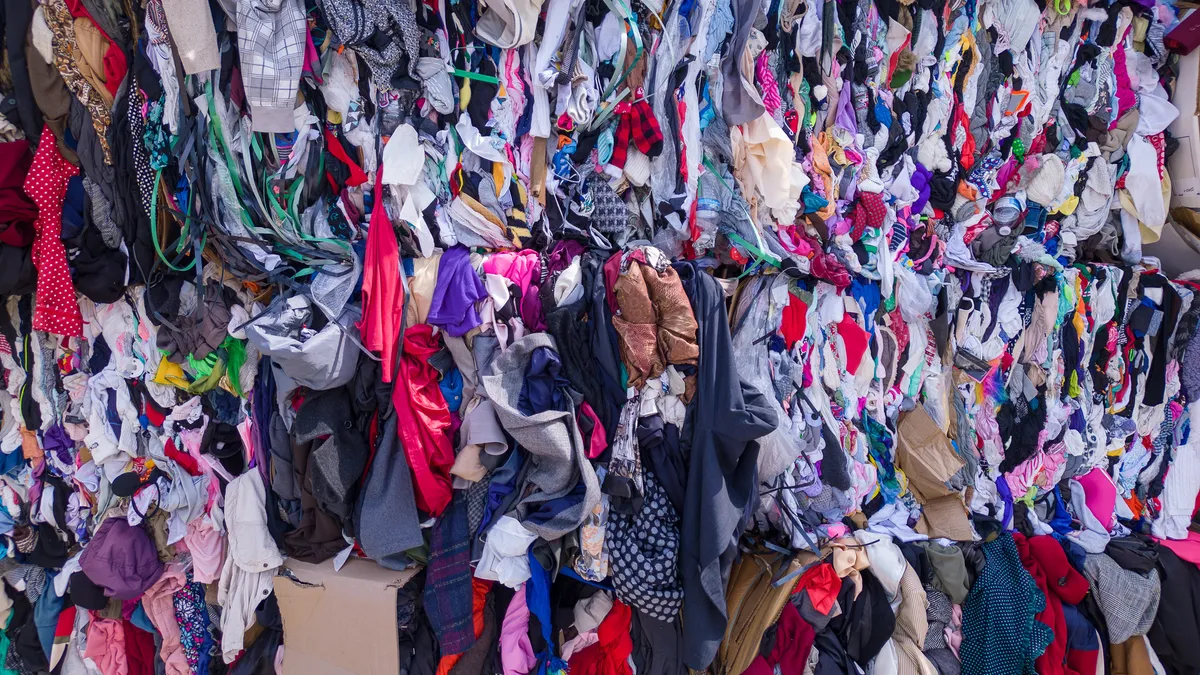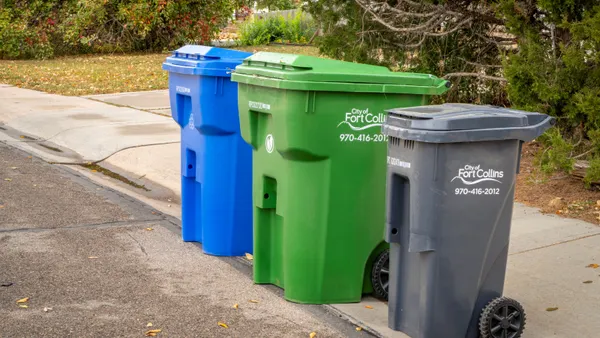Dive Brief:
- Following the results of a new study commissioned by Eastman, researchers advocate for a more circular approach to handling PET plastic and polyester textiles. A combination of methods could significantly raise recycling rates, promote reuse and improve waste diversion in the U.S. by 2040, the study says.
- The study suggests PET and polyester have “high potential for circularity” when implementing “well-designed” extended producer responsibility laws, packaging reuse programs, clothing resale options and investments in mechanical recycling. The report also calls for using chemical recycling methods for plastics that aren’t commonly recycled.
- Eastman operates a chemical recycling plant that uses types of “hard-to-recycle” PET and polyester as feedstock. Systemiq, an environmental services consultancy, conducted the study along with input from Closed Loop Partners, Eunomia Research and Consulting and The Recycling Partnership.
Dive Insight:
The study’s findings come as state and federal officials aim to reduce plastic pollution through new laws and long-term strategies.
California recently passed a first-in-the-nation EPR for textiles law meant to divert clothing and other materials from disposal. Meanwhile, the U.S. EPA just finalized its National Strategy to Prevent Plastic Pollution, which envisions developing a national framework for EPR and numerous other strategies to rein in such pollution by 2040.
The Systemiq study covers both PET packaging and polyester textiles, two feedstocks made with the same molecules but that have different recycling outcomes. Aside from items like PET plastic bottles, which are commonly recycled in many parts of the country, the report says the PET and polyester manufacturing system in the U.S. is mostly linear, with many items discarded after one use.
Packaging and textile materials make up about a third of a typical U.S. residents’ waste each year, the report says. Of that, about 30% is made from PET and polyester.
The study stated that about 7.9 million metric tons of PET and polyester packaging and textiles are sent to disposal each year, which it says would have a financial value of about $7 billion if they were recycled.
Study authors expect demand for PET and polyester packaging and textiles to grow faster than demand for items made with other kinds of materials. They estimate combined PET and polyester consumption will grow 1.5 times by 2040, which could generate 13 million metric tons of waste a year.
The study notes that a range of strategies — reuse, lightweighting, resale and both mechanical and chemical recycling — must be scaled up together. If that occurs, PET packaging recycling rates could rise from 23% up to 70%, researchers said in the report. The recycling rate for polyester textiles could grow from 1% to 19%.
“A collaborative effort across the value chain is needed to move away from our current take-make-waste system for polyester textiles and PET thermoforms and keep these valuable materials in play – rather than lose them to landfills and incineration,” said Kate Daly, managing partner at Closed Loop Partners, in a statement.
Such strategies could also help cut projected greenhouse gas emissions for packaging by about 60%. This “transformation” could generate $4.9 billion a year in additional revenue for U.S. recycling industries, the study says.
The report also touts the potential for more “depolymerization recycling,” a term considered to be under the chemical recycling umbrella, which it says is intended to “work alongside established mechanical recycling approaches.”
Such technologies have received notable investments in recent years, but have also faced criticism from community advocates who say the technologies’ economic and environmental effectiveness has not been proven, and that the large-scale facilities would strain communities already overburdened by pollution.
Eastman has long touted its new chemical recycling plant in Kingsport, Tennessee, as a key way to divert certain plastics from disposal. It has partnered with MRFs and local businesses to collect “hard-to-recycle” PET to use as feedstock for the facility, which it has described as the world’s largest of its type and capable of recycling 110,000 metric tons of plastic a year. Another plant is planned for Longview, Texas.
Chris Layton, Eastman’s director of sustainability for specialty plastics, said his company sees chemical recycling as a critical part of PET and polyester’s circularity, but it’s only one part of the strategy.
“Yes, we’re starting to have some of these chemical recycling facilities coming online at scale, and mechanical recyclers are continuing to evolve and improve,” he said. At the same time, “some reuse models are taking shape, and problematic materials lists [included as part of EPR programs] are reducing unnecessary plastics. And then on top of that, you're starting to see policy take shape.”
The study calls for U.S. policymakers to get more involved in recycling, reuse and diversion efforts. It suggests lawmakers promote laws, including for packaging and textiles, that include features like eco-modulation and postconsumer recycled content requirements. It also calls for packaging producers to reduce unnecessary packaging, design more products for reuse and use more domestically sourced recycled PET.
“Strong public-private partnerships and clear regulatory frameworks are essential to deliver the infrastructure, attract targeted investment and scale the change required to build a better recycling system,” said Kate Davenport, chief policy officer at The Recycling Partnership, in a statement.
Collaborating on better approaches to textile recycling will need to be a bigger priority in coming years, Layton added. While recycling systems are more established for some types of PET plastic, “textiles face a much more difficult sortation and separation process, because so often they’re made of blends and aren’t 100% polyester,” he said. “The technology will have to evolve.”
Eastman has a textiles line of business that makes fiber partially from recycled polyester, which is sold to brands like Patagonia and H&M, Layton said. “We are engaged in trying to help build out that textiles infrastructure” in the future, he said.
This story first appeared in the Waste Dive: Recycling newsletter. Sign up for the weekly emails here.










